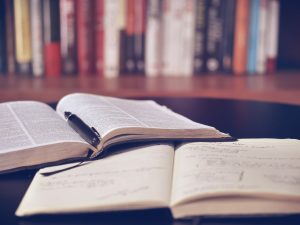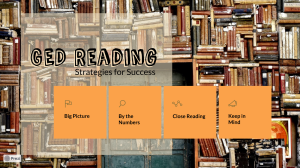44 GED Reading
Learning Objectives
-
Use metacognitive reading strategies before, during and after reading fiction, non-fiction and graphics.
-
Appropriately paraphrase and summarize texts.
Study Guide
Let’s start by working through our study guide together. Here is the link:
Click through the different sections of the presentation and discuss ideas and topics as they arise. The guide will include important information for navigating your next practice test.
Note on Study Guides
Study guides in this textbook are specific in-depth modules designed to be navigated via the attached presentation. The chapter below will offer general information on this week’s topics. For a deeper look at these topics, please access the presentation linked above.
Big Picture
The reading portion of the GED RLA Test will give you an hour and a half to answer questions about several readings. It will include:
- Reading for Literature
- Reading for Information
- Some Written Conventions
The questions are typically multiple choice, though sometimes they ask you to drag and drop multiple answers into categories.
The questions are often related to finding the main idea of a reading. Other questions include analyzing details and arguments.

By the Numbers
On the reading portion of the GED (not including writing):
Reading for Literature accounts for 30% of the questions
Reading for Information accounts for 60% of the questions
Written Conventions account for 10%
Of the reading questions, half are related to finding the main idea. The other half are about analyzing details and arguments
The conventions questions are dropdown questions that ask how to phrase sentences in specific contexts
Finding the Main Idea
Half of the reading comprehension questions will be some form of finding the main idea. Some things to remember:
The paragraph/reading was created to get that main idea to you, the audience.
Every idea is either the main idea or a supporting detail
When you read:
- Ask yourself if this is supporting another idea or if you think it’s the big idea
- Look for patterns to find the topic of the reading- then ask what the author has to say about that topic
- Look for other clues: bold words, titles, and topic sentences

Analyzing Details
The other half of the reading comprehension questions will involve analyzing details. Here are some examples of what you could see:
What does the author mean by using this particular word?
What evidence does the author use to support their claim?
Which of these ideas is included in the reading?
How are two authors’ ideas similar/different?
How does this data/chart prove the author’s argument?
What does the author mean by using this literary device?
Why is this element important to one of the characters?
Based on these details, what inferences can you make?
Keep in Mind
You get an hour and a half to complete the reading portion of the test. It’s a good idea to go through and see how many readings there are.
There are usually around seven questions per reading.
For literature, read the entire passage first. For informational readings, read the questions first.
If you’re stuck, move on and come back to this one.
Trust your gut. Some questions are tricky but there are no trick questions.
Assignment: GED Ready
Complete a GED Ready test for Reading & Language Arts using your GED.com account. If you score 145 or higher, schedule your official GED test.
If cost is a concern, please look into your local Adult Basic Education program (most likely through your local community college). They will have programs to reduce or eliminate the cost of the exams and the GED Ready tests.
Assignment: Reading Zone Response (250 Words)
For Reading Zone, you must find a novel that is interesting to you and enjoyable to read. If you need help finding a Reading Zone book, please ask. Please read your Reading Zone book for a half-hour each day. On class days, there will be time in class dedicated to reading.
Create a response to this week’s reading that addresses the following prompts:
-
In one paragraph, summarize what you’ve read this week
-
In a second paragraph, answer this week’s prompt: What is the main idea of this chapter? How does it help the author communicate the main idea of the book?


